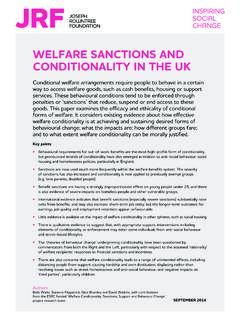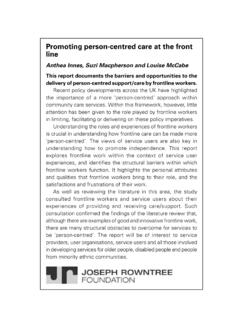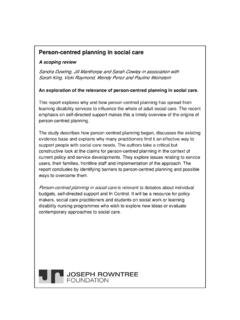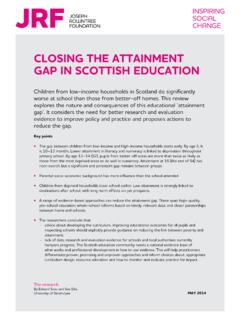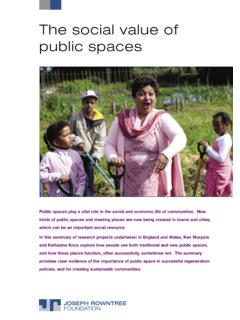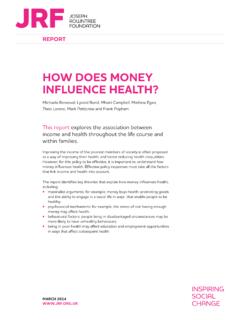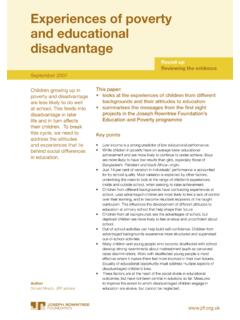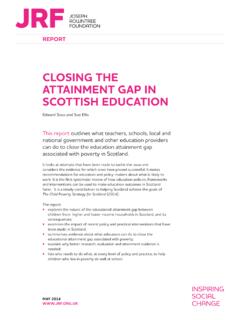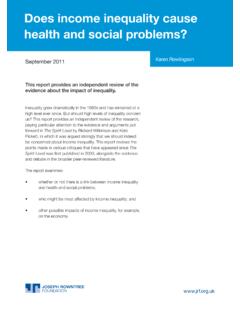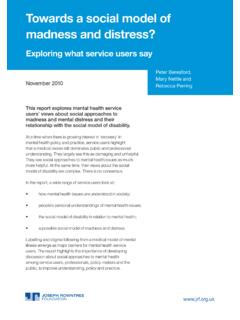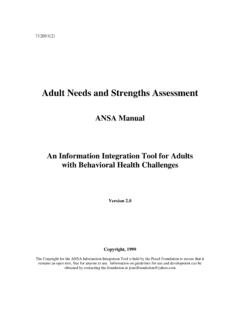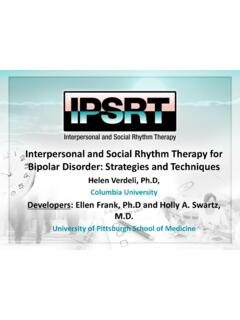Transcription of Parenting and resilience - JRF
1 Parenting and resilienceThis publication can be provided in other formats, such as large print, Braille and audio. Please contact:Communications, Joseph Rowntree Foundation, The Homestead, 40 Water End, York YO30 6WP. Tel: 01904 615905. Email: Hill, Anne Stafford, Peter Seaman, Nicola Ross and Brigid DanielParenting and resilienceThe Joseph Rowntree Foundation has supported this project as part of its programme of research and innovative development projects, which it hopes will be of value to policymakers, practitioners and service users. The facts presented and views expressed in this report are, however, those of the authors and not necessarily those of the Rowntree Foundation, The Homestead, 40 Water End, York YO30 6 WPWebsite: the authorsMalcolm Hill is Research Professor, University of Strathclyde.
2 He is Director of the Glasgow Centre for the Child & Society and Associate Director of the inter-university Centre for Research on Families and Stafford is Director, The University of Edinburgh/NSPCC Centre for UK-wide Learning in Child Seaman is Public Health Research Specialist at the Glasgow Centre for Population Ross is a Centre for Research on Families and Relationships Fellow, University of Daniel is Professor of Child Care and Protection, University of Dundee. University of Glasgow, 2007 First published 2007 by the Joseph Rowntree FoundationAll rights reserved. Reproduction of this report by photocopying or electronic means for non-commercial purposes is permitted. Otherwise, no part of this report may be reproduced, adapted, stored in a retrieval system or transmitted by any means, electronic, mechanical, photocopying, or otherwise without the prior written permission of the Joseph Rowntree : 978 1 85935 601 2A CIP catalogue record for this report is available from the British by:York Publishing Services Ltd64 Hallfi eld RoadLayerthorpeYork YO31 7 ZQTel: 01904 430033; Fax: 01904 430868; Website: copies of this report, or any other JRF publication, can be obtained from the JRF website ( ).
3 Contents1 Introduction 12 What are resilience and adversity ? 2 Academic and applied resilience ideas 2 Defi nitions of resilience 2 resilience outcomes, processes and capacities 3 Types of adversity 4 The location of resilience 6 Concepts within resilience 63 Evidence about children s and young people s resilience 8 Individual, intrinsic factors 9 Family factors 11 Environmental factors 15 Children s views 174 Evidence about parents and family resilience 19 Parents resilience 19 Family resilience 23 Applications to policy and practice 265 Critical appraisal of resilience 28 Individualistic approach 28 Defi nition diffi culties 29 Problems in operationalising resilience 306 Kindred concepts 32 Explicitly linked concepts 32 Implicitly linked concepts 32 Practice links 337 Conclusions 35 Positives in resilience approaches 35 Qualifi cations and drawbacks 35 Important distinctions 36 Key evidence 37 Priorities for future research 38 Note 40 References 41 Appendix.
4 A typical list of resilience factors 5911 IntroductionIn the last few years, the everyday word resilience has captured the attention and imagination of an increasing number of academics and professionals. resilience has positive connotations and entails understanding and seeking out good outcomes for individuals or families in circumstances where problems were to be expected. Compared with the traditional study of child development, which has tended to portray normal and abnormal patterns, a resilience approach offers a more differentiated account. In professional practice, resilience means looking for strengths and opportunities to build on, rather than (or alongside) problems, defi cits or psychopathology to be remedied or review considers parents actual and potential contributions to children s resilience and to parental resilience , which is sometimes subsumed within family resilience .
5 However, since most publications are concerned with resilience in relation to children and young people, the specifi c role of parents often has to be review draws on important UK-based publications on resilience and includes more selective references to the comparatively huge American literature, as well as signifi cant material from What are resilience and adversity ?Academic and applied resilience ideasThere is an important starting distinction to be made between research and theory on resilience and applied approaches making use of resilience in practice and policy. The fi rst embraces academic work to understand what factors and processes affect resilience . Theorisation and empirical investigations have been closely intertwined.
6 They have been located mainly within developmental psychology or psychopathology frameworks, but a minority have adopted a more social constructionist or postmodern stance ( Stein et al., 2000; Ungar, 2001, 2004a, 2004b). resilience frameworks for practice or policy apply the fi ndings and ideas from research to provide or strengthen the resources available to individuals or families, in order to promote well-being and nitions of resilienceSeveral writers have noted that there is no consensus regarding the defi nition of resilience ( Kinard, 1998), but rather a cluster of meanings associated with doing better than expected in diffi cult circumstances. Sometimes resilience is used to refer to general coping skills and mechanisms that help with the common challenges of everyday life.
7 However, in both academic and practice contexts, the key feature of resilience is usually a capacity to deal with severe adversity, so that two crucial conditions need to be present (Luthar et al., 2000; Gilligan, 2001):n a signifi cant threat or diffi cult circumstancesn positive is this analysis of differentiated responses to adversity that offers something over and above conventional developmental psychology, attachment theory and assessments of children s nitions of resilience include the following, with different emphases and elements:.. normal development under diffi cult circumstances.(Fonagy et al., 1994, p. 223)3 What are resilience and adversity ?.. the ability of some individuals to maintain healthy functioning in spite of a background of disadvantage commonly associated with poor outcomes.
8 (Ghate and Hazel, 2002, p. 15).. developing well despite risk status or exposure to adversity.(Masten and Powell, 2003, p. 2).. when, against common expectancies, children maintain development within, or accelerate markedly after , adverse situations.(Clarke and Clarke, 2003, p. 23)Judgements about what constitutes normal development , healthy functioning or common expectancies will vary according to time, culture and outcomes, processes and capacitiesResilience has often been portrayed as an outcome (relatively good functioning or well-being), but it is also important to consider it as a set of qualities or processes that enable a person to make use of internal and external resources (Schofi eld, 2001; Yates et al.)
9 , 2003). resilience can also be viewed as a capacity that causes the good outcome. An oft-quoted defi nition by Masten et al. (1990) indicates that resilience may be any of these three:.. the process of, capacity for, or outcome of successful adaptation despite challenging and threatening the sake of clarity it is helpful to use double terms, such as resilient outcomes, resilience processes or resilience factors, to distinguish as outcome is usually portrayed as comparative when people do better than expected or than normal . Sometimes resilience is identifi ed when an individual in diffi cult circumstances does as well as the average person not facing the same pressures or hurdles to overcome. It can also mean being less affected than others who experience similar adverse experiences.
10 It may entail being affected like others, but recovering more quickly or better afterwards. Hence, resilience does not always involve doing well during or even shortly after stressful circumstances, but in the longer term. As Luthar and Zelazo (2003) state, resilience itself is not a separate variable, but is inferred from measures of adversity and positive adaptation. They suggest that adaptation is usually shown by relative success but, when very severe trauma is considered, then the absence of psychiatric diagnoses is suffi and resilienceThere can also be degrees of resilient outcome. Gilligan (1997) refers to a spectrum of resilient outcomes ranging between survival, coping and thriving. But resilience is not necessarily generalised across all domains (Luthar, 1991; Anderson, 1997).
